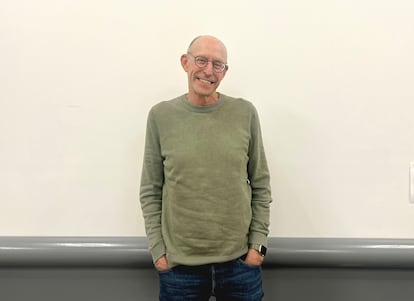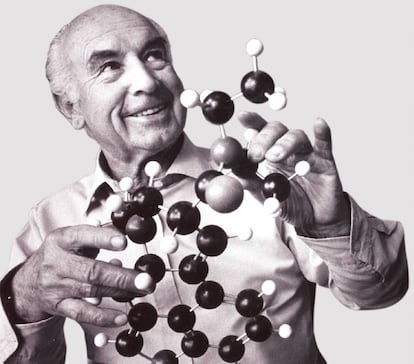Michael Pollan: ‘There’s a dangerous message that psychedelics will solve all your mental health problems’
The author of ‘How to Change Your Mind,’ a key text in the resurgence of scientific research on psychoactive substances, worries about the creation of a ‘bubble’

It’s October 2018 and Michael Pollan, one of America’s most respected journalists, is in New York, at his mother’s Park Avenue apartment. He has had a successful career writing about food and eating, and now he has just published a book on the resurgence of the scientific use of psychedelic substances, following decades of prohibition, called How to Change Your Mind. He says he thought that it would be a “small book” on a unique topic. “I was writing about something that was not a universal subject that was very fringe…and so I thought maybe we [will] move the needle a little bit.”
Almost five years have gone by since then, and that “small book” has moved the needle quite a bit. In fact, his book even reached Ted Lasso, television’s most famous soccer coach. In the final episode of the series-cum-phenomenon, the character appeared on screen reading Pollan’s book after three seasons of struggling with anxiety and other mental health issues. But Ted’s not alone in his interest about the tome. Pollan’s book has become the bible of a scientific, economic, social and cultural movement in the United States. It also serves as a travel guide for people who, like Lasso, are seeking answers beyond traditional psychiatric treatments.
“At least 10 people sent me screengrabs of that scene,” the 68-year-old American author recalled in an interview with EL PAÍS in late June in Denver. “Since my book came out, substances have taken center stage in the culture. [It] was ready for a shake [up]. We have a mental health crisis, especially among the young, but rates of depression and suicide and anxiety are going up. COVID made that worse. And so there was a need for new approaches to treating mental health. And at the same time, the pushback I expected to encounter from the psychiatric establishment, the mental health establishment, didn’t materialize. They were more embracing of this than I thought. And the reason is because they know they’re being swamped by the problem too. And they know their tools aren’t very good, that antidepressants aren’t working as well as they once did, and they never worked that well.”
Pollan was in Colorado to participate in the Psychedelic Science 2023 conference, which drew a record-breaking crowd of 12,000 attendees to talk about the present and future of the “psychedelic renaissance.” Meanwhile, the country is counting down the months until the Food and Drug Administration (FDA) approves MDMA and psilocybin for therapeutic use to treat patients with post-traumatic stress disorder and terminally ill cancer patients. This newspaper spoke with Pollan after he appeared on stage in a 5,000-seat auditorium where NFL quarterbacks (Aaron Rodgers), rock musicians (Melissa Etheridge), actors (Willow Smith), legendary psychonauts (Amanda Fielding), apostles of mycology [the study of fungi] (Paul Stamets) and numerous researchers from some of the most prestigious universities in the United States converged at a conference to talk about drugs.

Pollan explained that, in the short distance that separated the theater from the room where the conference organizers hid him so that he could speak calmly, “ten people” stopped him to let him know that, beyond changing their minds, his book—which was turned into a Netflix documentary series—had “changed their lives.” He candidly admitted that it made him feel " a little jealous [and]a little bit intimidated also. I’ve had a few experiences that have been helpful, but they haven’t been transformative.” But he added that he was proud of “reaching into new communities, not just affluent white males who are the classic second-wave Psychonauts… [the book is] reaching women and reaching people of color.”
The book told the story of this new trend through the prism of a virtual neophyte’s personal experience and from the perspective of the first round of scientific research on these substances in the 1950s and 1960s. During that period, some 40,000 Americans took these drugs in clinical settings. That ended when LSD, a molecule that Albert Hoffman synthesized in 1938, and psilocybin, with which Timothy Leary experimented at Harvard, ended up on the streets, where they were used recreationally. Richard Nixon criminalized them in 1970, at the dawn of the “war on drugs.”
A group of psychologists and psychedelic explorers—who are revered as heroes today at meetings like the one that took place in Denver—kept the flame alive underground, until the substances gradually returned to mainstream scientific research this century. Pollan hopes that earlier mistakes will not be repeated this time. “We treated it as a thrill…without much preparation or integration or intention. It was careless… [what if] we had not been so arrogant and [had] been willing to look at …how Native Americans use peyote? And [asked], how do South Americans or Central Americans use psilocybin? There were really important lessons there that went unlearned and that was just [because of] Western arrogance.” He also worries about unrealistic expectations about what psychedelics can do: “I feel that…you could have overexuberance and oversell and then people will be disappointed.”
Asked if he believes that there is a psychedelic bubble in the United States, the writer replies, “Yeah, I think there’s a lot of hype and I worry [that] people will be disappointed. These trials have had some very encouraging results, but you have to understand that they’re…optimized for success…[In them], you get to choose your very small sample very carefully. These [are] psychologically stable people, and they want to participate. They’re very positive about it. So, when you’re treating depression in a broader population, the results are not going to be as good and that’s not unusual. That’s true for all drugs; they get approved based on the ideal case. But I do think there’s an overselling that goes on... And…it’s not unique to psychedelics. We live in a culture where hype is king. We’re great at marketing. We’re great… at inflating balloons.”
Pollan goes on to caution that “there’s some dangerous messages…that all psychedelics [can] solve all the problems in the world, and [will solve] all your mental health problems. I mean, I’ve heard people say that seriously here. And I don’t think we’ve proven that…I think there are dangers in therapist abuse. [There are] unscrupulous underground therapists, taking advantage of people. There’s profiteering going on. People [are] charging outrageous amounts of money for psychedelic therapy because the demand is so high. There are guides that have just announced that they’re guides and don’t know what they’re doing. They just put up a shingle. What are they going to do when something seriously bad happens? They’re going to call 911 and be worried about their own legal status, their tremendous risks.”

The rituals observed for these treatments at places like the Johns Hopkins University Center for Psychedelic and Consciousness Research in Baltimore include a quiet room, an eye mask, some music, the presence of a therapist during the trip, and sessions with a psychologist before and after to prepare for the experience, which can be deeply unsettling, and for assimilation afterward. Part of the FDA’s work is to set rigorous protocols and a system for training and credentialing new practitioners of psychedelic medicine.
The drug in your coffee
One needs to have a good reason to participate in one of these experiments, for example, being diagnosed with terminal cancer. In How to Change Your Mind, Pollan, “a guy without any problems,” went underground to try high doses of LSD, psilocybin (mushrooms) and DMT (ayahuasca). And he continued his explorations in his next book This Is Your Mind on Plants. In it, he studies three other substances: a “tranquilizing” one, opium; a “stimulating” one, caffeine (a “powerful drug that hides in plain sight”); and another “expansive” one, mescaline, a psychedelic that he had yet to try.
The result is three long reports in which Pollan takes the reader through the process of his own learning. In the one on caffeine, he stops using it to observe what the effects of the substance are: “headache, fatigue, lethargy, difficulty concentrating, decreased motivation, irritability, intense distress, loss of confidence and dysphoria, the polar opposite of euphoria.” He explained in the interview that “a lot of people have told me they stopped taking it after reading the book. I tell them I was just looking to try to recalibrate my relationship with coffee, and then I went back to it. Why give up that great pleasure?”
It is interesting to read the text on opium in light of the fentanyl crisis, a narcotic 50 times stronger than heroin, which plagues the United States. The piece is actually an adaptation of an article that the author decided to publish in censored format in the 1990s to avoid legal problems. It was “at the height of the war on drugs,” and he wondered whether he, a seasoned plant lover, might end up in jail for growing poppies at home. What he didn’t know, he adds, is that while police were going after “gardeners and seed merchants,” pharmaceutical companies like Purdue were sowing the seeds of the opioid crisis by aggressively marketing Oxycontin pills.
“[The situation has] changed a lot since 2021…I mean, the problem…has gotten much worse…And fentanyl is now showing up in MDMA and in all different kinds of things….More than 100,000 people died of [an] overdose last year. It’s astonishing numbers. We had only 500,000 total addicts back in the late 1990s, in a country of about 250 million. It wasn’t a big number. And now we have 100,000 people dying of overdose,” Pollan reflects. He adds that the psychedelic resurgence and what the DEA already considers the worst drug crisis in this country’s history (the Fentanyl crisis) may be related. “Psychedelics may help deal with opiate addiction. There’s an experiment getting underway that has shown some success in treating opiate addiction…this… kind of blows people’s minds because they think, oh, drugs are drugs. How can you use one drug to treat another drug addiction? But you can’t [think of it that way]…We have to take each drug on its own terms. They are so different.”
As part of his new life as an apostle of psychedelics, the writer and professor of nonfiction at Harvard and of scientific journalism at the University of California, Berkeley, founded the Center for the Science of Psychedelics at the latter university in 2020. He has also focused on research and outreach. As part of that second mission, this week he endorsed the presentation of a survey on the American public’s perception of these substances. The poll concludes that 61% of registered voters support allowing their therapeutic use, that 56% would like them to be distributed with a prescription and that half would approve the decriminalization of their possession and consumption. So far, Colorado has already taken this step with hallucinogenic mushrooms, while Oregon became the first state to legalize them for therapeutic use this year.
Sign up for our weekly newsletter to get more English-language news coverage from EL PAÍS USA Edition
Tu suscripción se está usando en otro dispositivo
¿Quieres añadir otro usuario a tu suscripción?
Si continúas leyendo en este dispositivo, no se podrá leer en el otro.
FlechaTu suscripción se está usando en otro dispositivo y solo puedes acceder a EL PAÍS desde un dispositivo a la vez.
Si quieres compartir tu cuenta, cambia tu suscripción a la modalidad Premium, así podrás añadir otro usuario. Cada uno accederá con su propia cuenta de email, lo que os permitirá personalizar vuestra experiencia en EL PAÍS.
¿Tienes una suscripción de empresa? Accede aquí para contratar más cuentas.
En el caso de no saber quién está usando tu cuenta, te recomendamos cambiar tu contraseña aquí.
Si decides continuar compartiendo tu cuenta, este mensaje se mostrará en tu dispositivo y en el de la otra persona que está usando tu cuenta de forma indefinida, afectando a tu experiencia de lectura. Puedes consultar aquí los términos y condiciones de la suscripción digital.
More information
Archived In
Últimas noticias
Raúl Rocha, from jet-setting with Miss Universe to arms trafficking and fuel theft
80,000 barrels of Mexican oil sent to Cuba: Havana drawn into the US–Mexico clash
Human rights activists, opposition members, and a minor: Maduro’s other political prisoners
Israel sparks a civil war within the MAGA movement
Most viewed
- Reinhard Genzel, Nobel laureate in physics: ‘One-minute videos will never give you the truth’
- Pablo Escobar’s hippos: A serious environmental problem, 40 years on
- Charles Dubouloz, mountaineering star, retires at 36 with a farewell tour inspired by Walter Bonatti
- Why we lost the habit of sleeping in two segments and how that changed our sense of time
- The fall of a prolific science journal exposes the billion-dollar profits of scientific publishing











































